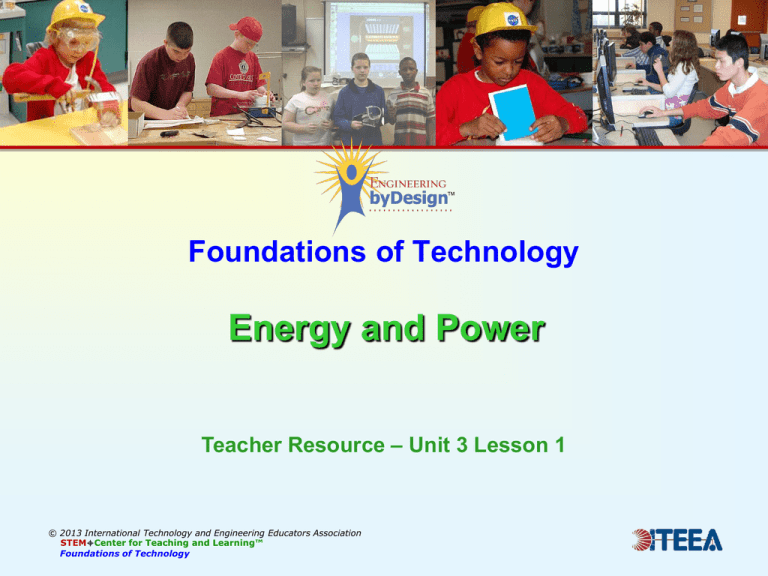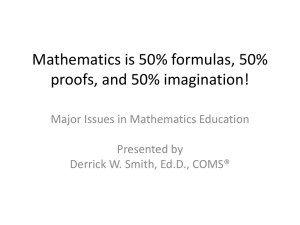Thermodynamics
advertisement

Foundations of Technology Energy and Power Teacher Resource – Unit 3 Lesson 1 © 2013 International Technology and Engineering Educators Association STEMCenter for Teaching and Learning™ Foundations of Technology The BIG Idea Big Idea: Advancements in the processing and controlling of energy have been an enabling factor in the development of technology. © 2013 International Technology and Engineering Educators Association STEMCenter for Teaching and Learning™ Foundations of Technology Thermodynamics There are four laws of thermodynamics that help to define things like energy, the flow of energy, and temperature. Each law helps to define how these physical properties behave as well as to determine what is and is not possible. © 2013 International Technology and Engineering Educators Association STEMCenter for Teaching and Learning™ Foundations of Technology Thermodynamics Zeroth Law of Thermodynamics Helps to Define Temperature – “If each of two systems is equal to a third, then the first two are also equal.” © 2013 International Technology and Engineering Educators Association STEMCenter for Teaching and Learning™ Foundations of Technology Thermodynamics The First Law of Thermodynamics: The Law of Conservation of Energy – “Energy can neither be created nor destroyed, however energy can flow from one form to another.” © 2013 International Technology and Engineering Educators Association STEMCenter for Teaching and Learning™ Foundations of Technology Thermodynamics The First Law of Thermodynamics: Internal Energy and the Relationship to Temperature – “If a system has a temperature, then the total energy of the system has three parts—kinetic energy, potential energy, and internal energy—and as the internal energy increases, so does the potential energy.” © 2013 International Technology and Engineering Educators Association STEMCenter for Teaching and Learning™ Foundations of Technology Thermodynamics The First Law of Thermodynamics: Heat Flow is a Form of Energy Transfer – “Heat that flows from a hot system to a cold system can be expressed as energy transfer.” © 2013 International Technology and Engineering Educators Association STEMCenter for Teaching and Learning™ Foundations of Technology Thermodynamics The First Law of Thermodynamics: “When a tool/machine moves an object, the object absorbs some of the energy from the tool/machine.” Performing Work is a Form of Energy Transfer Work is equal to the force you exert and the distance an object moves. W=FXD © 2013 International Technology and Engineering Educators Association STEMCenter for Teaching and Learning™ Foundations of Technology Thermodynamics The Second Law of Thermodynamics Energy Flows Away From its Source – “Energy or heat cannot move from a cold system to a hot system, and you cannot continually produce work without adding energy Source because energy flows away from its source.” © 2013 International Technology and Engineering Educators Association STEMCenter for Teaching and Learning™ Foundations of Technology Thermodynamics The Third Law of Thermodynamics As a System Approaches Absolute Zero, Energy is Not Produced – “Molecules cease to move as temperatures reach absolute zero, thus energy is not produced.” © 2013 International Technology and Engineering Educators Association STEMCenter for Teaching and Learning™ Foundations of Technology Thermodynamics Quick Review: The Zeroth Law helps to define temperature. First Law of Thermodynamics discusses: Law of Conservation of Energy Internal Energy and the Relationship to Temperature Heat Flow is a Form of Energy Transfer Performing Work is a Form of Energy Transfer © 2013 International Technology and Engineering Educators Association STEMCenter for Teaching and Learning™ Foundations of Technology Thermodynamics Quick Review: The Second Law of Thermodynamics states that energy flows away from its source. The Third Law of Thermodynamics states that as a system approaches absolute zero, energy is not produced. © 2013 International Technology and Engineering Educators Association STEMCenter for Teaching and Learning™ Foundations of Technology How Energy is Generated 1. Coal is transported into the plant, where it is burned, producing chemical energy. 2. The heat or thermal energy created causes water from the condenser to form steam. © 2013 International Technology and Engineering Educators Association STEMCenter for Teaching and Learning™ Foundations of Technology 3. The steam turns the blades of the turbine, which is attached to the generator. 4. The generator converts the mechanical energy into electrical energy. Electrical energy is stored and transported to the consumer. Power Systems All Power Systems have a source of energy, a process, and a load. Using the previous example of Coal: Source Process Load • Coal • Combustion of Coal to Turn the Turbine • The Infrastructure (houses, business, industry) Connected to the Power System © 2013 International Technology and Engineering Educators Association STEMCenter for Teaching and Learning™ Foundations of Technology Forms of Energy There are six major forms of energy: 1. Thermal – or heat, the vibration/movement of atoms within systems. 2. Radiant – or light, the electromagnetic energy that travels in transverse waves. 3. Electrical – energy made available by the flow of an electric charge through a conductor. © 2013 International Technology and Engineering Educators Association STEMCenter for Teaching and Learning™ Foundations of Technology Forms of Energy There are six major forms of energy: 4. Mechanical – energy stored in the movement of objects or systems 5. Chemical – energy stored in the bonds of atoms and molecules (examples: biomass, petroleum, natural gas, and coal) 6. Nuclear – energy stored in the nucleus of an atom—the energy that holds the nucleus together © 2013 International Technology and Engineering Educators Association STEMCenter for Teaching and Learning™ Foundations of Technology Renewable Vs. Non-Renewable Power plants generate electricity from various energy resources. Energy sources can be classified as: Renewable: Non-Renewable: Water Fossil Fuels Wind Uranium Solar © 2013 International Technology and Engineering Educators Association STEMCenter for Teaching and Learning™ Foundations of Technology Renewable Energy Renewable energy is energy that comes from natural resources like water, wind, and solar. Hydroelectric power plants use the downward flow of water to turn the blades of a turbine. Wind works similarly; as wind blows, it turns the blades of a turbine. Solar power plants generate electricity by converting the radiant energy from sunlight to electrical energy. Renewable energy accounts for 17% of the worlds energy sources. © 2013 International Technology and Engineering Educators Association STEMCenter for Teaching and Learning™ Foundations of Technology Non-Renewable Energy Nonrenewable resources are resources that are limited or fossil fuels, like coal, oil, and natural gas. Fossil fuels provide around 81% of the world’s electrical power. However, oil and coal power plants produce harmful environmental emissions. © 2013 International Technology and Engineering Educators Association STEMCenter for Teaching and Learning™ Foundations of Technology Non-Renewable Energy Nuclear power is also considered a nonrenewable energy source. Nuclear power is generated using uranium and produces around 3% of the world’s energy needs. The heat generated from fission when atoms split releases heat energy which produces steam and turns the blades of a turbine. © 2013 International Technology and Engineering Educators Association STEMCenter for Teaching and Learning™ Foundations of Technology Energy Flow Diagrams There are two common diagrams used to show the flow of energy within any system: Sankey Diagram Flow Diagram Both are used to show what is happening to a particular type of energy as it is used or changed in a process or situation. © 2013 International Technology and Engineering Educators Association STEMCenter for Teaching and Learning™ Foundations of Technology Energy Flow Diagrams A Sankey Diagram shows the type of energy that goes into a system and how the energy is converted, which also includes wasted energy, usually in the form of heat. © 2013 International Technology and Engineering Educators Association STEMCenter for Teaching and Learning™ Foundations of Technology Energy-Flow Diagrams A Flow Diagram depicts how energy moves through a system and includes the type of energy and how that energy is generated and stored. The example to the right shows how energy moves through a Hybrid Car. © 2013 International Technology and Engineering Educators Association STEMCenter for Teaching and Learning™ Foundations of Technology







